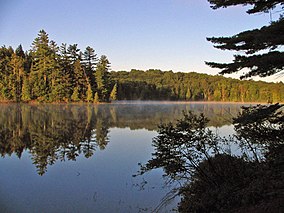| Adirondack Park | |
|---|---|
 Long Pond, in the Saint Regis Canoe Area | |
 Park area highlighted in green, bounded by the Blue Line, within New York state | |
| Location | New York, United States |
| Area | 9,375 sq mi (24,280 km2) |
| Established | New York State Forest Preserve |
| Named for | Mohawk for tree eaters. |
| Operator | Adirondack Park Agency, New York State Department of Environmental Conservation |
Adirondack Forest Preserve | |
| Area | 2,000,000 acres (8,100 km2) |
| NRHP reference No. | 66000891[1] |
| Significant dates | |
| Added to NRHP | October 15, 1966 |
| Designated NHL | May 23, 1963 |
The Adirondack Park is a park in northeastern New York protecting the Adirondack Mountains. The park was established in 1892 for "the free use of all the people for their health and pleasure", and for watershed protection.[2] At 6.1 million acres (2.5×106 ha), it is the largest park in the contiguous United States.[3]
Notable among parks in the United States, about 52 percent of the land is privately owned inholdings. The remaining 48 percent is publicly owned by the state as part of the Forest Preserve. Use of public and private lands in the park is regulated by the Adirondack Park Agency.[4]
The Adirondack Park contains 46 High Peaks, 2,800 lakes and ponds, 30,000 miles (48,000 km) of rivers and streams,[3] and an estimated 200,000 acres (81,000 ha) of old-growth forests.[5][page needed] It is home to 105 towns and villages, as well as numerous farms, businesses, and a timber-harvesting industry. The park has a population of 130,000 permanent and 200,000 seasonal residents, and sees over 12.4 million annual visitors.[3] The inclusion of human communities makes the park one of the most successful experiments in conserving previously developed lands in the industrialized world.[6]
The Adirondack Forest Preserve was designated a National Historic Landmark in 1963.[7]
- ^ "National Register Information System". National Register of Historic Places. National Park Service. November 2, 2013.
- ^ Annual Report of the Forest Commission 1892. www.archive.org accessed July 21, 2020
- ^ a b c "About the Adirondack Park". Adirondack Council. Retrieved January 9, 2024.
- ^ Adirondack Park Agency Act, L. 1971, c. 706, enacted 25 June 1971; L. 1973, c. 348, enacted 22 May 1973.
- ^ McMartin, Barbara (December 1, 1994). The Great Forest Of The Adirondacks. Utica, New York: North Country Books. ISBN 978-1595310033.
{{cite book}}: CS1 maint: date and year (link) - ^ Porter, William; Erickson, Jon; Whaley, Ross (2009). The Great Experiment in Conservation: Voices from the Adirondack Park (1st ed.). Syracuse, N.Y.: Syracuse University Press. pp. xxvii–xxxiii. ISBN 978-0-8156-3231-3.
- ^ "National Register Information System". National Register of Historic Places. National Park Service. January 23, 2007.